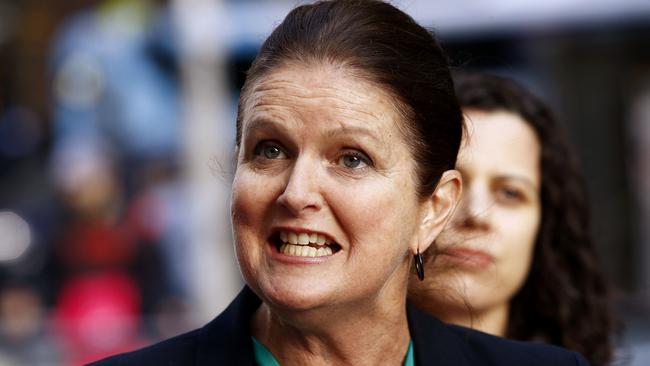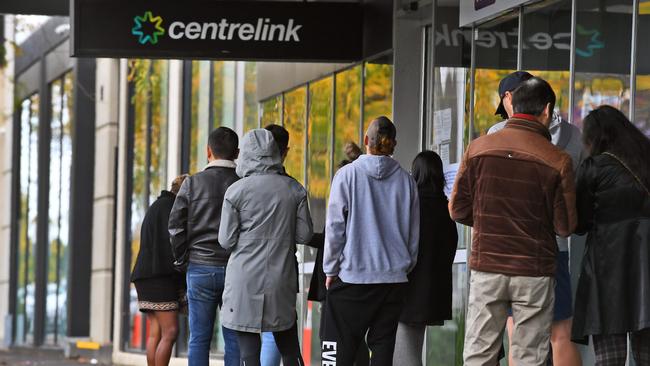Sweeping overhaul of JobKeeper, JobSeeker support payments unveiled by Scott Morrison
Scott Morrison is overhauling and extending support payments during the coronavirus crisis, but two million workers will be off wage subsidies after September and 1.6 million people on the dole will lose $300 a week.
Two million workers will be cut out of the JobKeeper wage subsidy scheme after September in an overhaul which Scott Morrison expects will prompt major businesses restructures.
The fortnightly $1500 payment will be tapered back to $1200 at the end of September and then $1000 in January, with a lower tier of $750 and then $650 also introduced for some casual and part time staff.
The initial $70 billion JobKeeper package supports 3.5 million workers from March until September, but as health restrictions are eased, the government expects only 1.4 million workers will receive the subsidies once business turnover is tested again in two months.
The Prime Minister said the next six-month phase would cost $16.6 billion, and that it would be a “good day for Australia” when fewer businesses had to rely on the subsidies.
With Melbourne still in lockdown, Victorian businesses will draw on more support than those in other states, as Mr Morrison said it was time for employers to “make judgments about who they’re going to keep on and then who they won’t be able to keep on”.
“JobKeeper is designed to find its level with those businesses who need it most,” he said.
Mr Morrison said he expected “quite a number” of workers on JobKeeper to move to the JobSeeker unemployment benefit after September.
A fortnightly $550 coronavirus supplement which has doubled the dole will be slashed to $250 from the end of September until the end of the year, despite an effective unemployment rate of 11.3 per cent.
The federal government expects that three-month measure will cost $3.8 billion — meaning 2.17 million people would be receiving the supplement at that time, down from 2.3 million currently.
After revelations 875,000 workers received an average $550 fortnightly wage boost in the first stage of JobKeeper, Labor leader Anthony Albanese said the scheme’s design had added to “a record deficit and record debt”.
Treasurer Josh Frydenberg said the lower tier of payments — for staff working less than 20 hours a week — would respond to this, applying to 175,000 workers between October and December and then 125,000 workers from January to March.
One million workers are still expected to be on JobKeeper when the next six-month phase expires.

Australian Hotels Association national chief Stephen Ferguson welcomed the extension but said the eligibility rules needed updating, particularly because of Melbourne’s lockdown.
“Given the length of forced shutdowns and the nature of our highly casualised, mobile and often seasonal workforce, we are seeing the continuity of employment starting to break down,” he said.
“As JobKeeper is only payable for those employees who were with the employer on 1 March 2020, this would decrease the assistance to those businesses which have been shut down the longest as they are trying to reopen.”
Australian Chamber of Commerce and Industry boss James Pearson said extending JobKeeper provided “the certainty businesses need to plan for the end of this income support”, but he warned “downsizing in some businesses is inevitable” in coming months.
Reserve Bank Governor Philip Lowe said the economy had “turned the corner” but still faced a “bumpy path ahead”.
SOCIAL SERVICES GROUPS FEARFUL OF WELFARE CHANGES
Dole payments will be slashed by $300 a fortnight for 1.6 million unemployed Australians after September as tightened welfare rules will mean they have to start applying for jobs.
A fortnightly $550 coronavirus income support supplement will be cut to $250 in two months, meaning those on JobSeeker benefits will be paid $815 a fortnight until the end of the year.
Mutual obligation rules requiring dole recipients to apply for four jobs per month to retain their payments kick in from August 4 — when Melburnians will still be living in lockdown.
Scott Morrison said the changes were about moving to the “next phase” of the economic recovery and encouraging people back to work where possible.
Social services groups welcomed the continued support but warned it would not be enough after December as the recession continues.

The Prime Minister said he was “leaning heavily” into continuing bolstered unemployment payments into 2021, instead of returning JobSeeker to the pre-pandemic level of $40 a day.
The $550 supplement is currently paid to 2.3 million Australians, including about 700,000 on other welfare payments including Youth Allowance.
Under the changes, JobSeeker recipients can earn $300 a fortnight before facing a reduction in their benefit, but means testing arrangements will be reintroduced.
Australian Council of Trade Unions boss Sally McManus said allowing recipients to earn more money was welcome but would only benefit those who could find work.
The Australian Council of Social Service warned the lack of clarity beyond this year would leave millions of people anxious and financially insecure.
“The full supplement should be maintained until it is replaced with a permanent, adequate increase,” chief Dr Cassandra Goldie said.
“This decision will also have flow-on effects across the entire economy. Millions of people will have less to spend on the essentials in local businesses, which in turn could lead to further economic pain and unemployment.”
Mr Morrison said from August, dole recipients would have to reconnect with employment services and apply for jobs. They will have to accept any job that is offered.
“The penalties regime will kick in if people refuse a job that has been provided,” he said.

With support payments to be reviewed again later in the year, Anglicare Australia acting executive director Imogen Ebsworth said the government needed to be clear about what out-of-work Australians could expect,
“Changes to JobSeeker will push Australians into poverty just as they need to be getting on their feet,” she said.
Opposition social services spokeswoman Linda Burney called for a permanent increase to JobSeeker.
WHAT SUPPORT CAN YOU CLAIM?
JobKeeper: Wage subsidy paid to workers via employers
30 March — 27 September
Paid to 960,000 businesses supporting 3.5 million workers
Businesses eligible if turnover dropped by at least 30 per cent at any point during the pandemic compared to the same time last year
$1500 fortnightly subsidy for all full time and part time staff, as well as casuals who were in the same job for more than 12 months before the pandemic
28 September — 3 January
> Expected to be paid to businesses for 1.4 million workers
> Businesses eligible if turnover dropped by at least 30 per cent between April and September this year compared to the same period last year
> $1200 fortnightly subsidy for staff who were working more than 20 hours a week in the month before 1 March 2020
> $750 fortnightly subsidy for all other eligible staff
4 January — 28 March
> Expected to be paid to businesses for 1 million workers
> Businesses eligible if turnover dropped by at least 30 per cent between April and December this year compared to the same period last year
> $1000 fortnightly subsidy for staff who were working more than 20 hours a week in the month before 1 March 2020
> $650 fortnightly subsidy for all other eligible staff
Coronavirus supplement: Extra support for recipients of JobSeeker, Youth Allowance and other welfare payments
27 April — 24 September
> Supporting 2.3 million people including 1.6 million on JobSeeker
> $550 fortnightly supplement (on top of $565.70 fortnightly JobSeeker base rate for an individual with no children)
25 September — 31 December
> Expected to support 2.2 million people
> $250 fortnightly supplement (on top of $565.70 fortnightly JobSeeker base rate for an individual with no children)
> Australians can receive full JobSeeker payment and coronavirus supplement while earning up to $300 a fortnight, up from $106 per fortnight
> Means testing arrangements reintroduced for income support payments
> From August 4, those on JobSeeker will have to connect with employment services and undertake four job searches a month, with that requirement to increase after September
MORE NEWS
THINGS TO KNOW ABOUT JOBKEEPER, JOBSEEKER CHANGES
